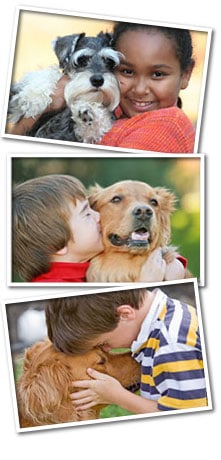Dogs are loving members of the family, but they can get irritated just like any other member of the family. Dogs communicate mostly through body language, so simply by learning to recognize these signs, a family can learn to understand how their dog is feeling in different situations. Some examples of a dog showing anxiety are: licking its lips when food is not present, placing its tail between its legs, and ears back and panting. It’s very important to avoid placing the dog in situations that cause anxiety and fear. Children should be taught not to tease dogs, pull on them, yell at them, or make loud noises around them. Although dog bites are rare, preventative measures should be taken to protect the family from dog bites and to protect the dog from anxiety-inducing situations. Please read the following for more tips on preventing dog bites:
Advice for Children
Do not touch a dog while it is eating or sleeping. Just like humans, a dog may not want to be touched during these activities and it can also become possessive of food.
Alert an adult if you see a dog off leash outside. Do not go near the dog
Staring directly into a dog’s eyes can be intimidating and scary to them. Make sure to avoid aggressive body language and loud noises around dogs.
Ask the owner’s permission before petting a dog. When going to pet the dog, let the dog first sniff your closed hand.
If a strange dog approaches, do not run. Stand very still, like a tree, and keep limbs close to your body. Dogs like to chase things, so moving objects make them want to run and jump. Staying still will bore the dog, and eventually it will walk away.
If a dog knocks you to the ground, curl up in a ball, keep limbs and fingers in, and stay quiet.
Remember that dogs are living creatures. Face touching, being jumped on, or being yelled at is annoying to anyone, especially a dog.
Tips for Parents
Even though the dog is a member of the family, it is still important to supervise children when they spend time with the dog.
Teach children about canine body language, what to do when they greet a dog, and never to touch a strange dog without permission.
Practice safety yourself when approaching dogs. Children will mimic your behaviors.
Have frequent discussions with children about what they should do if a dog attacks or displays aggressive behavior.
Consider taking the family dog to obedience classes so both the dog and the whole family learn which behaviors are acceptable. Older children can be involved in the training, but do not allow children to punish the dog. The dog should see the time spent with children as a positive experience.
Help for New Dog Owners
Spaying or neutering a dog is not only helpful to control the pet population, it can help a dog have a calmer mentality. Neutered pets are often less aggressive. Neutering also prevents unwanted litters that could end up strays or in poor conditions that would make the puppies poorly socialized, leading to aggressive behaviors.
Socializing a new dog or puppy is very important. The dog should be exposed to many types of situations and people in order to reinforce these things as positive experiences.
Learn to spot warning signs of aggression. Dogs often give warning before biting, but since they cannot communicate like us, become familiar with dog body language and tell-tale signs that the dog is getting frustrated.
Maintain a well-fenced yard so the dog cannot jump over the fence or dig out underneath and escape. Also, make sure the dog’s leash is in good condition at all times and its collar properly fitted so the dog can’t get off leash in public.
Always supervise the dog when it meets new people and children. Strangers may act in a way that is foreign to the dog, and he or she could react negatively.
Links
Dog Bite Prevention for Children
How to Avoid a Dog Bite
Tips to Prevent Dog Bites
Biting: Causes, Prevention, and Control
Victoria Stillwell’s Dog Bite Prevention
Socializing Your Puppy or Adult Dog To Get Along With the World
Raising a Puppy: Training Your Puppy to Be People Friendly
Understanding Aggression in Dogs
Canine Body Language – Keeping Families Safe
Why Dogs Bite
Kids and Dogs: Safety First
Safety Around Dogs

